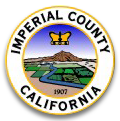
Salton Sea and Salinity
Salton Sea Salinity and Saline Water
Ali Montazar
In this area, salinity is usually associated with the Salton Sea. So what is salinity? The word salinity refers to the presence of salts in waters and soils. It refers to more than just sodium or chloride, the two elements of table salt. Magnesium, calcium, carbonate, bicarbonate, nitrate, and sulfate can all contribute to salinity. The suitability of water for drinking, irrigation, or wildlife depends on the type and concentration of dissolved salts in water. The salinity of water is usually expressed in term of a measured parameter that is affected by all the dissolved salts in water. Electrical conductivity (EC) is the parameter that is most currently used to express salinity. Total dissolved salts (TDS) expressed as the mass of dissolved salts per unit volume of water is also used to express the salinity of water. The primary source of salts in waters and soils is chemical weathering of earth materials (rocks and soils). Natural secondary sources of salts along coastal areas include atmospheric deposits of oceanic salts, and seawater intrusion into groundwater basins and into estuaries. Atmospheric salt deposition also occurs in the interior of continents. The deposition rate decreases with distance from the ocean. Other secondary sources of salts found in soils are saline water from rising ground waters, inland saline lakes, and leaching of saline lands. The ocean is the primary source of salts found in natural salt deposits. These were laid down under the direct influence of an ocean during earlier geologic periods and subsequently uplifted. More commonly, however, the direct source of salts is surface and ground waters. All of these waters contain dissolved salts, the concentration depending upon the salt content of the soil and geologic materials with which the water has been in contact. There are other sources of salts which are the result of human activity: they include irrigation and drainage water, chemical fertilizers, animal wastes, sewage sludges and effluents, and oil- and gas-field brines. Most waters on earth are salty because oceans contain approximately 97% of the water on earth and most of the fresh water is frozen in glaciers. The salinity of the Pacific Ocean is approximately 35,000 mg/L (1 ppm=1 mg/L). Colorado River water salinity is about 650-700 mg/L. Salton Sea salinity is about 44,000 mg/L, that is approximately 4.4% salt. The amount of salts that is deposited in the Imperial Valley agricultural land with irrigation water is approximately four million tons of salts annually. To maintain crop productivities, equal amount of salts must be leached from the root zone. Surface and subsurface drainage waters are carried to the Salton Sea via agricultural drains and rivers (Alamo and New rivers). The concentration of salt in the Salton Sea increases by a rate of approximately 1% annually. The present Salton Sea was created in 1905-07 when Colorado River Flooded the Sonoran Desert. Over the past 1300 years, the region was flooded five times; the elevation of the Sea was approximately 300 ft higher than the current elevation. While agricultural water discharges to the Sea increase the total salt load, the concentration of salt is currently maintained because of the relatively fresh agricultural drainage water that enters the Sea. The concentration of salts in the Sea increases mainly because of evaporation. If agricultural drainage water (approximate salinity level is 4,000-4,500 mg/L) is ceased or significantly reduced for just a few years, Salton Sea salinity will increase at a tremendous rate, Salton Sea water level will decline, and fish will die. The Salton Sea is mainly sustained by drainage water. Water conservation practices can improve water use efficiency but cannot eliminate drainage water. In general, water conservation practices increase the concentration of salt in drainage water while reducing the volume of drainage water. While it’s not readily visible, leaching the soil of excess salts in arid and semi-arid regions is an essential agricultural practice.
